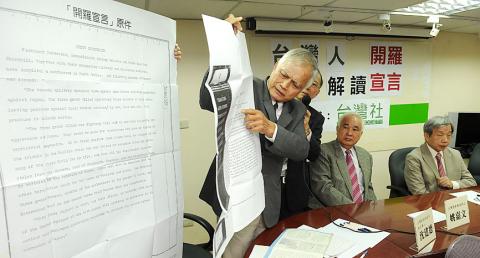|
Cairo Declaration as
legal basis incorrect: advocates
‘FALSE PERCEPTION’: A history professor said
that the president’s interpretation of the Cairo Declaration could bolster
Beijing’s sovereignty claim over the Diaoyutai Islands
By Chris Wang / Staff reporter

Former Examination Yuan president
Yao Chia-wen, center, and Taiwan Society chairman Chang Yen-hsien, right, listen
as Sim Kiantek speaks yesterday at a press conference in Taipei on interpreting
the Cairo Declaration.
Photo: Wang Min-wei, Taipei Times
President Ma Ying-jeou’s (馬英九)
interpretation of the Cairo Declaration, issued on Dec. 1, 1943, as the legal
basis of Taiwan’s “return” to the Republic of China (ROC) after World War II was
not only incorrect, but also dangerous because his rhetoric was exactly the same
as that of Beijing, pro-independence advocates said yesterday.
“[Ma’s interpretation] fits right in with the ‘one China’ framework, which would
be interpreted by the international community as saying Taiwan is part of China
because hardly anyone would recognize the China in ‘one China’ framework as
referring to the ROC,” Taiwan Society President Chang Yen-hsien (張炎憲), a former
president of the Academia Historica, told a press conference.
The Treaty of San Francisco, signed on Sept. 8, 1951, should have been the only
legal document to determine Taiwan’s status, not the Cairo Declaration in 1943,
nor the Potsdam Declaration of 1945, Chang and other experts said at the press
conference, held almost at the same time as a commemoration ceremony for the
70th anniversary of the First Cairo Conference, organized by the Presidential
Office.
Since Ma took the same position on the declaration as Beijing, which cited it as
the legal basis for Taiwan’s return to China, he is risking two important
issues, said Vincent Chen (陳文賢), a professor at National Chengchi University’s
Graduate Institute of Taiwan History.
“With Ma taking the same position, Beijing could bolster its argument about
Chinese sovereignty over the Diaoyutai Islands (釣魚台), which it claimed had been
returned to China along with Taiwan and Penghu in the declaration,” Chen said.
“[Ma’s] adherence to the ‘one-China’ framework could, in the long run, create a
false perception among the international community that Taipei and Beijing would
follow the post-World War II unification models of Vietnam and Germany and unify
in the future,” he said.
While the declaration, which was released in the form of a press communique
after the meeting of Chiang Kai-shek (蔣介石), then-US president Franklin Roosevelt
and then-British prime minister Winston Churchill in Cairo, said that “all the
territories Japan has stolen from the Chinese, such as Manchuria, Formosa, and
the Pescadores, shall be restored to the Republic of China,” the ROC referred to
the country which was in the state of war with Japan, not the country which is
now in Taiwan with different people and territory from “the old ROC,” Taiwan
Nation Alliance convener Yao Chia-wen (姚嘉文) said.
The context of the Cairo Declaration would be better interpreted by examining
the post-World War II developments and comments made by leaders of involved
countries, the advocates said.
Yao said that Churchill told the British parliament on Feb. 1, 1955, that he
would not accept the view that the declaration could be used as a binding
document to claim that China has sovereignty over Taiwan, adding that Japan’s
prime minister and foreign minister had also made it clear that Japan renounced
its claim over Taiwan and did not hand it to anyone.
Since the declaration was not a treaty but a communique, it did not transfer
Taiwan’s sovereignty, Provisional Government of Formosa executive secretary Sim
Kian-tek (沈建德) said.
Moreover, the communique was not signed by any leaders because Roosevelt and
Churchill had different views about how to handle Taiwan’s future, Sim said.
|
![]()
![]()
![]()